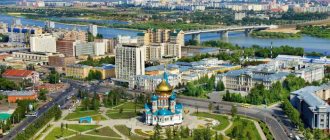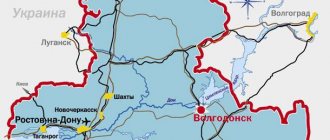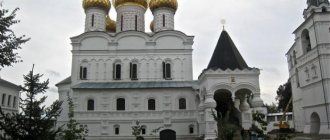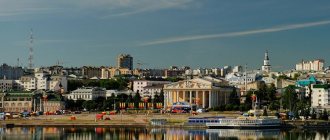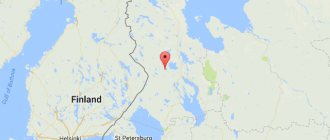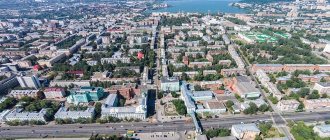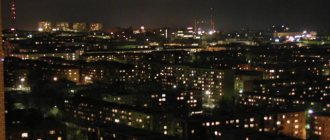The city of Simferopol is located in the central part of the Crimean Peninsula in the foothills - a hollow formed at the intersection of the valleys of the Outer and Inner ridges of the Crimean Mountains. Nowadays it is the capital, cultural, economic, educational and logistical capital of the Republic of Crimea, one of the two largest populated areas of the Republic of Kazakhstan.
There is no sea here, only a reservoir created in 1954 (it was filled with water in 1956), fed from the Salgir River (the longest in Crimea). The bowl of the reservoir is elongated in shape at its widest point - 1500 m, the surface area is about 317 hectares, depth (on average) - 11 m (the deepest place is 32 m). The banks of the artificial reservoir were planted with pine trees, fish were released into the water - pike perch, vendace, crucian carp, carp, ram, which were not previously found in Salgir, there are also local species - pike, roach, bream, perch. The fish have taken root - private fishing is allowed here, but the zone is protected - any type of economic activity is prohibited.
Where is the city in Crimea?
Simferopol is located in the central part of the peninsula, between the spurs of the Crimean Mountains and the valley of the Salgir River, on the banks of a large reservoir. These places have a healthy and dry climate, characteristic of the foothills. Winters are very mild and summers are hot. The territory that the city now occupies was once the site of Scythian Naples, destroyed by the Huns in the 3rd century. Modern Simferopol dates its history back to 1784.
Simferopol on the map of Crimea
GENERAL INFORMATION
- Population – over 335 thousand people.
- Area – 107 km2.
- Founded in 1974
Kebir-Jami Mosque
The date of construction of the mosque is the beginning of the 16th century. It is believed that the white lime-covered walls of the facade of the oldest building in the city at one time gave it its name - Ak-Mosque (see above). Kebir-Jami is the main mosque of Crimea, which looks very simple in appearance. After the revolution it continued to function, but was closed in the post-war years. The building housed a bookbinding workshop. After the Crimean Tatars deported during the war returned to the peninsula, the mosque was returned to them. Its restoration began in 1991 and lasted almost two decades.
Kebir-Jami Mosque
The mosque complex houses the spiritual administration of the Muslims of Crimea, the residence of the mufti, a madrasah and a library with literature in the Crimean Tatar language.
Address: st. Kurchatova, 4. Directions: by buses 8, 11, 47, 57 and 78 to the stop “Ul. Lenin". The mosque is open to the public except during prayer times.
Where to stay on vacation in Simferopol?
You can stay in the city at numerous hotels and inns. For those who like isolated living, the private sector offers its services,
where you can rent an apartment without intermediaries and at an affordable price. There are also frequent hostels in Simferopol that offer cheap stopover services.
The modern hotel complex “Rio” is always ready to welcome new guests. Its magnificent rooms ensure a wonderful stay. They have undergone high-quality repairs and installed suspended ceilings. Climate control systems maintain optimal temperatures in rooms. All household appliances are of excellent quality. Meals are provided in the restaurant; dinner can be ordered directly to your room. The staff is friendly and polite.
At the Dayana Hotel you can stay with all comforts in cozy rooms of three categories. The suites and junior suites of this Simferopol hotel have balconies. Good repairs have been carried out everywhere. The premises are air conditioned and equipped with decent household appliances. There is a restaurant and bar on site. From here you can book various excursions around Crimea and even fishing.
The small hotel "Yalos" offers guests comfortable accommodation in its cozy and well-renovated rooms, equipped with all necessary household appliances. You can eat on your own, preparing food in the shared kitchen, or in one of the nearby cafes. Here you can rent a car for traveling around Crimea. A holiday in Simferopol spent in this hotel implies good quality of service and affordable prices.
Features of culture and traditions
In the capital of Crimea, there are certain rules and traditions that are important for tourists to take into account. The main features of staying here are as follows:
- from May to September there are many tourists in the city, so it is best to book hotel rooms in advance;
- You should follow safety rules and be careful. For example, you cannot purchase tickets or anything else from private individuals, and it is also important to keep valuables and documents under supervision;
- The historical district of Simferopol is best explored during the day and as part of a tourist group, and you can walk around the central district until late in the evening, but it is noisy and there are many nightclubs.
The most interesting places in Simferopol
One of the most recognizable landmarks of the city is the Dolgorukovsky obelisk, erected here in 1842 in honor of the victory of the Russian army led by Prince V.M. Dolgoruky-Crimean over the army of the Crimean Khan, which brought Russia dominance in the lands of the peninsula. It looks like a stepped pyramid 20 m high.
sagging massive cast iron chains. The composition is completed by ancient cannons and hexagonal lanterns.
Undoubtedly, it is necessary to take an excursion to the ruins of the ancient city of Scythian Naples, which for a long time was the capital of the late state of these steppe nomads. Excavations are still underway at the site, since archaeologists have not yet explored even a twentieth of its area. Artifacts found on the territory of this landmark of Simferopol helped scientists change their view of the Scythians. Fortress walls and other structures are being reconstructed using historical materials.
The Museum of Archeology in Simferopol is of great interest to the inquisitive tourist. When vacationing in Crimea, be sure to visit it. It is divided into three sections, each of them tells about different periods of human life on the peninsula: the prehistoric past, the slave period and the Middle Ages. Here you can see unique artifacts. The exhibitions are very colorful, and the institution's collection is very extensive.
Holy surgeon
Crimeans and Simferopol residents are rightfully proud of their outstanding fellow countryman, known in religious circles as St. Luke. From 1946 until his death in 1961, he headed the city Cathedral with the rank of Archbishop of Crimea. Luke was one of those rare clergy who fully fulfilled the commandments of Christ. All his life he selflessly helped the poorest and most vulnerable people, not differing too much from them in his modest attire. He recognized the authority of Christ alone and was principled and independent in his judgments and actions. In pre-war Soviet times, the future archbishop was repeatedly arrested and spent 11 years in exile. It would seem that this was a fairly common fate of a priest during the Soviet period.
Saint Luke
But this amazing personality also had an extremely interesting secular hypostasis.
Valentin Voino-Yasenetsky is an outstanding Soviet surgeon, one of the founders of Soviet purulent surgery, Doctor of Medical Sciences, Stalin Prize laureate (the only clergyman).
At the beginning of the war, Voino-Yasenetsky from Krasnoyarsk exile sent a telegram addressed to Kalinin offering the Red Army his services as a highly qualified surgeon. The request to temporarily interrupt the exile was granted, and Voino-Yasenetsky, appointed chief surgeon of the Krasnoyarsk evacuation hospital, saved many wounded Soviet soldiers. And in 1942 the church authorities entrusted Bishop Luke with the leadership of the Krasnoyarsk diocese.
After the military hospital moved to Tambov in 1944, Doctor Voino-Yasenetsky continued his active medical work, at the same time heading the local diocese of the Russian Orthodox Church. Under his leadership, about a million rubles were collected and transferred to the needs of the front. In 1946, the archbishop, who had not fully served his exile, became a laureate of the Stalin Prize of the first degree for the development during the war of innovative methods of surgical treatment of purulent wounds. He donated two-thirds of the prize, which was huge at that time, to post-war orphanages that were in dire need of it.
After his death, the archbishop was canonized by the Ukrainian Orthodox Church in 1995. And the Russian Orthodox Church canonized its bishop as a new martyr and confessor in 2000. Krasnoyarsk Medical University bears his name. In 2013, a feature film “Cure Fear” was shot about Luka Krymsky. In 2015, the documentary film “Healer Luke” was shown on Channel One. In the Holy Trinity Cathedral of Simferopol, where the bishop served, there is a small museum of his (see below).
Where to go with children in Simferopol?
A child who has attended a performance of the Crimean Academic Puppet Theater will receive wonderful impressions. It is the oldest on the peninsula, having received its first spectators back in 1939. The repertoire of this institution includes a wide variety of performances. There are always very colorful decorations here, among which colorful plays are performed
puppet characters who evoke grateful applause from the public with their performances.
You can have a great and very interesting time with the whole family in the Square, which bears the name of the 200th anniversary of Simferopol; there is plenty of entertainment for children here. In it, right among the alleys, there is an exhibition of the unique Museum of Forged Figures. Here you can see magnificent works of artistic forging - from literary and historical heroes embodied in metal to magnificent cast-iron roses. A souvenir photo taken against their background will be simply wonderful and will delight the children.
A real exciting adventure for a child and parents will be an excursion to the Emine-Bair-Khosar cave, located in the city surroundings. During the underground journey, accompanied by a guide, you can get a lot of great experiences and take amazing photos. Here you will see giant stalagmites reaching a height of 10 m and amazing stone waterfalls.
Number, ethnic composition and main occupations of the population of the city of Simferopol
According to data as of the beginning of 2022, in the urban district, which includes the administrative center itself and the adjacent urban-type settlements of Aeroflotovsky, Agrarnoe, Gresovsky, Komsomolskoye, as well as the village of Bitumen at the railway station. Simferopol-Gruzovoy station, home to 341.5 thousand people. Ethnic composition according to the autumn census of 2014: Russians - 66.8%, Ukrainians - 20.8%, Crimean Tatars - 7.4%, other nationalities (Belarusians, Jews, Azerbaijanis, Armenians, etc.) - 5%.
The main occupation of Simferopol residents is working at industrial enterprises: there are about 70 production units in the engineering, food and light industries. Among them: – the largest enterprise in Eastern Europe for the production of power tools and ship automation, a mechanical cannery named after. CM. Kirov, factories - leather goods, sewing, pasta and confectionery, enterprises producing household chemicals and essential oils. A significant part of the population works in the transport sector.
Where can you eat in Simferopol?
The best restaurant in the city, where political, pop and sports stars have dined many times,
The establishment is considered to be Chistye Prudy. The hall, decorated in a classic style, has beautiful furniture and excellent table settings. The menu includes dishes of European, Armenian and Japanese cuisine, the taste of which will satisfy demanding gourmets.
The Valencia restaurant is interesting because one part of it is located in an old wine cellar. In such an interior you can have a very fun dinner, enjoying the taste of European cuisine. The wine list is extremely varied. The sommelier will help you choose the right drink.
Photo gallery: maps of different areas
The airport is located in the village of Aeroflotsky (12 km northwest of the center of Simferopol)
The botanical garden is located near the center of Simferopol
The Kievsky district of Simferopol has quiet streets and a provincial atmosphere
On the outskirts of Simferopol there is a park and stadium
There is a highway near the reservoir in Simferopol
The center of Simferopol is the busiest
How to get (get there) from Moscow?
You can get from Moscow to Simferopol in various ways. The easiest one is air travel. Most flights depart from Domodedovo, however, Vnukovo and Sheremetyevo also send planes. The flight interval ranges from 10-50 minutes. Travel time is about 2.5 hours.
It is also possible to get to Simferopol from the Russian capital by train, although you cannot do without transfers in Krasnodar or Anapa. Bus service is also established - transport departs from Shchelkovsky AB, Yuzhnye Vorota AB, Krasnogvardeyskaya AS or Novoyasenevskaya AS. Travel time will be 27…35 hours.
Tourists are increasingly going on holiday to Crimea. Simferopol is a very interesting place to spend your holidays. There are so many different attractions here that one short trip is not enough to see them all. However, the wonderful impressions from it will remain for a long time! At the end, watch an interesting video walk around the city.
Liked? Share with your friends!
Karaite kenasa
Crimea is one of the habitats of a small people - the Karaites. In everyday life, being close to the Turks, they, however, profess a special branch of Judaism. Karaite houses of worship are called kenasa (accent on the last syllable). They are found in several Crimean cities, but Simferopol is considered the most beautiful. This kenasa was built at the end of the 19th century, next to the former prayer house, which could no longer accommodate the growing Karaite community. The beautiful building, combining elements of Byzantine, Moorish and Gothic architectural styles, was built with funds raised by the community.
With the establishment of Soviet power, the Karaite community in 1922 signed an agreement with the local branch of the NKVD on the unhindered use of kenasa. Since 1930, the diminished religious community could no longer support the kenasa. At her suggestion, a Karaite club functioned in the building for three years. Since 1936, the building was transferred to the Crimean Television and Radio Center. At the same time, the building was deprived of cult attributes: in particular, the six-pointed star was replaced by a five-pointed one.
Since 1979, the building received the protected status of an architectural monument. In post-Soviet times, the building was returned to the Karaite religious community. After the annexation of Crimea to Russia, a partial restoration of the kenasa was carried out.
Karaite kenasa
Address: st. Karaimskaya, 6. Directions: minibuses No. 57 and 78 to the stop “Ul. Sergeev-Tsensky".
Botanical phenomena
In the courtyard of a five-story building at st. Frunze, 30 you can see a botanical phenomenon - a five-trunked chestnut tree, whose age is approaching two hundred years. In 1829, the famous doctor and scientist Fyodor Milgausen, who lived nearby, planted seven chestnut fruits in one hole - according to the number of members of his family. Five of them were accepted, which eventually grew together, forming a common trunk with a diameter of more than five meters. At a height of two meters the trees disperse.
Five-trunk chestnut
Another unique tree can be seen in the Simferopol Children's Park. The age of the giant oak, whose trunk diameter exceeds six meters, is estimated at 6–7 centuries. The oak has its own name - “Hero of Taurida”. According to some researchers, this particular oak is the prototype of Pushkin’s “oak near Lukomorye”. In development of this version, a “Glade of Fairy Tales” with characters from Pushkin’s fairy tales was created in the Children’s Park.
Oak "Bogatyr of Taurida"
Mammoth Cave (Emine-Bair-Khosar)
A kilometer from the Marble Cave is Mammoth Cave, which received its name from the mammoth skeletons found inside.
Mammoth Cave
A visit to the Mammoth Cave is possible as part of one of three excursion routes:
- “Northern Gallery” – 30 minutes/350 rubles;
- “Northern Gallery” – 1 hour 15 minutes/450 rubles;
- Full route – 1 hour 28 minutes / 500 rubles.
The opening hours of the Mammoth Cave are no different from the Marble Cave - from 8 a.m. to 6 p.m. In Crimean cities you can purchase not only separate, but also combined tickets to these two nearby caves. In the Mammoth Cave it is even colder than in the Mramornaya Cave - only 50C. For frivolous tourists, there is a rental of warm jackets (10–15 rubles).
The Tatar name of the cave Emine-Bair-Khosar is sometimes confused with another cave with a similar name Emine-Bair-Koba, which, as a rule, is visited only by suitably equipped speleologists.
Shevchenko Cinema
Address: Simferopol, st. Gorky, 5.
The cinema building was built in 1904 by entrepreneur Leonid Sukhomlinov. In 1915, Yalta architect N.P. Krasnov added an arch decorated with stucco molding to it. In the Soviet years, the cinema was called “Star of the Revolution”, later “Bolshevik”, and under the Germans “Pallas”. In 1954, the cinema was named after Taras Grigorievich Shevchenko. The cinema has been showing films for more than a century; its purpose has never changed.
Crimean Academic Theater named after M. Gorky
Address: Simferopol, st. Pushkina, house 15.
Sights of Simferopol include cultural sites, such as the Crimean Academic Russian Drama Theater named after M. Gorky. The interesting architecture of the building attracts the attention of many tourists. The theater is located on the main street of the city. A. S. Pushkin.
The history of the oldest theater in Crimea began in 1820. Archival data suggests that the Moscow merchant Volkov, being a keen theatergoer, decided to establish a stage in a stone barn at the house of the noble assembly. Its modest appearance did not prevent the theater from becoming the center of cultural life in Crimea. The original name was the Simferopol Noble Theater.
Forty years later, a separate theater building was built; its hall accommodated 410 seats; it has not been preserved. The modern building, designed by architect A. N. Beketov, was built in 1911 in the neoclassical style with Art Nouveau elements. The main façade of the theater is decorated with sculptures and busts.
During the occupation of Simferopol, the underground group “Falcon” operated in the theater that continued to operate. Its director was the chief artist of the theater, Nikolai Baryshev. A month before the liberation of Simferopol, the Sokol group was discovered, and its members were captured and sent to the Krasny concentration camp. On April 10, they were shot in the Dubki tract, Simferopol region, and on April 13, the city was liberated.
In memory of the underground workers, a memorial plaque was installed on the theater building with the names of the actors and theater workers who were part of the Sokol group. The play “They Were Actors” based on the play by V. Orlov and G. Nathanson, which premiered at the theater in 1973, is also dedicated to their memory. The play was also released into a film of the same name at the Mosfilm studio in 1981.
Links
- Website of the city of Simferopol
- Simferopol – Information Center
| Settlements of Crimea | |||
| cities: | Alupka | Alushta | Armyansk | Balaclava | Bakhchisarai | Belogorsk | Dzhankoy | Evpatoria | Inkerman | Kerch | Krasnoperekopsk | Saki | Sevastopol | Simferopol | Old Crimea | Sudak | Feodosia | Shchelkino | Yalta | ||
| villages: | Gaspra | Gurzuf | Kacha | Koktebel | Kirovskoe | Koreiz | Krasnogvardeiskoe | Lenino | Livadia | Massandra | Marine | Nizhnegorsky | Nikita | New World | Parthenite | Pervomayskoe | Perekop | Razdolnoye | Simeiz | Soviet | Foros | Black Sea | ||
Chocolate Museum
The “History of Chocolate from Chocolate” museum is located in Simferopol, in the Salon du chocolat cafe.
Entrance to the Salon du chocolat cafe
The museum, as the name suggests, is interesting because almost all of its exhibits are made of chocolate.
We had to spend one and a half tons of this delicacy on the museum’s collection. Here you can see the gnomes' house with miniature chocolate furniture, the chocolate Eiffel and Leaning Towers of Pisa. When making the Eiffel Tower weighing 150 kg, consultation with a mathematician was required. The Swallow's Nest made of white chocolate on a cliff made of dark chocolate looks very impressive.
Chocolate “Swallow's Nest”
The museum also has spectacular multi-colored chocolate paintings, in the production of which artist-chocolatiers use natural food dyes.
Chocolate painting
The lifespan of chocolate exhibits is approximately five years.
Naturally, touching and, especially, eating the exhibits is strictly prohibited. Volnitsa is coming to the cafe at the museum, where everything can be bought and eaten. Including a bouquet of chocolate roses, a chocolate “Faberge egg” or a box of chocolate jewelry. Address: st. Kirova, 66. The confectionery is open from 9 to 22 hours. Tours, which require pre-registration, run from 10 a.m. to 6 p.m. The ticket price is 200 rubles, and at the end of it the ticket (chocolate one, of course!) can be eaten. Children under six years old are admitted free, but without a chocolate ticket. Directions to the stop “Ploshchad Kuibysheva”:
- buses 3, 6, 7, 30, 49 and 70;
- trolleybuses 4, 7, 10 and 22;
- minibuses 1, 2, 8, 10, 13, 15, 41, 48, 54, 60, 63, 68, 69, 80, 81, 83, 85, 86, 105, 114 and 118.
Holy Trinity Cathedral
In the second half of the 19th century. The majestic Holy Trinity Cathedral was built on the site of the Greek Orthodox Church.
Holy Trinity Cathedral
In the 30s of the XX century. the temple's property was confiscated and it was closed. It was planned to house a children's boarding school in the building. However, the local Greek community, part of which had Greek citizenship, managed to achieve the re-opening of their temple in 1934. Moreover, after the destruction of the Alexander Nevsky Cathedral, the Holy Trinity Church received the status of Cathedral. In 1946, it was headed by Archbishop Luka of Crimea (see above). In 1996, his relics were transferred to the cathedral and are now his relic, kept in a silver shrine. And the cathedral itself is sometimes called after him.
Relics of Luke of Crimea
Another valuable shrine is the “Sorrowful” icon of the Mother of God.
She is famous for the fact that in 2004, on the feast of the Dormition of the Virgin Mary, her dim, barely visible image was renewed and sparkled with fresh colors. In 2002, the Synod of the Ukrainian Orthodox Church transformed the Holy Trinity Cathedral into a convent of the same name, and temporarily (until the reconstruction of the Alexander Nevsky Cathedral) transferred the status of the Cathedral to the Peter and Paul Church.
Address: st. Odesskaya, 12. Opening hours: 9–18. The St. Luke's Museum is open Wednesday - Sunday from 9 a.m. to 4 p.m. Ticket price – 70 rubles. Travel: by trolleybuses 4, 9 and 12 or minibuses 48, 54, 62, 63, 68–70, 73, 80, 83, 85, 86, 91, 99, 114, 115 and 118 to the stop “Silpo”, formerly called "Lenin Square".

